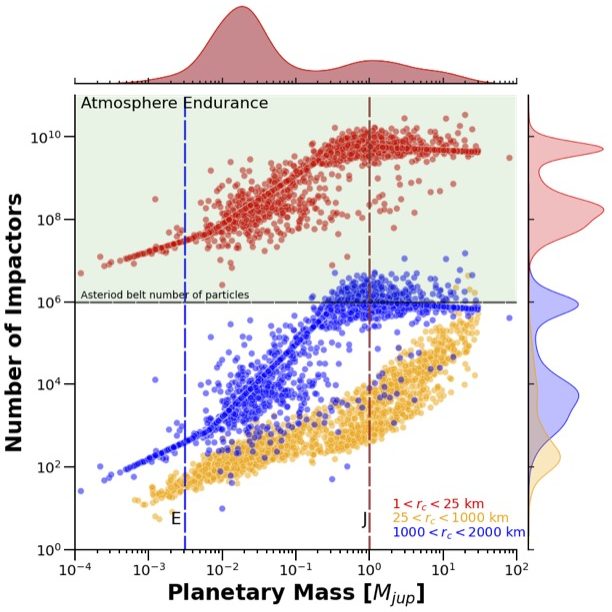Planetary Systems Dynamics
Comet Collision Theory
Three main processes dominate the dynamical evolution of comets in planetary systems: planet-comet interactions, stellar flybys, and/or stellar companion perturbations. These lead to comet collisions, capture, and ejection, creating Kuiper belt/Oort cloud-like structures, planet family comets, and interstellar comets. In particular, the interaction of planets with comets plays a vital role in the planetary system morphology and evolution. I developed a novel analytic formulation (Eq. 1) for accurately calculating the rates at which comets collide due to interacting with planets [Torres et al., 2023a, Torres et al. 2023d]. With this model, we can predict planetary atmospheric loss due to cometary impacts, the formation of a family of comets orbiting planets, and the interstellar comet production rate for different planetary architectures. These predictions will help guide future observational surveys to search for planets with stable atmospheres, cometary structures around planets, and objects in interstellar space.
Eq. 1 Represents the most general expression to calculate the collision timescale between a minor body and a planet in an arbitrary geometry. This approach allows us to consider an arbitrary orbital configuration for the planet and comet. The variables in Eq. 1 represents:
Nc= Number of particles
ap= Planet’s semi-major axis
Rp= Planetary radius
Mp= Planetary mass
ic= Comet’s inclination
G= Gravitational constant
vrel= Relative velocity planet-particle
Planetary Atmospheres
The existence of a planet’s atmosphere is thought to be vital for the occurrence of life on planets and understanding planet formation (Ali-Dib, et al. 2021). However, planetary atmospheres can be in jeopardy due to cometary impacts (Madhusudhan 2019, Schlichting et al., 2015) that can lead to a complete atmospheric loss or a radical change in the planet’s internal evolution (Schlichting et al., 2015, Wyatt et al., 2020). To better understand the vulnerability of the planetary atmospheres in different environments. I developed a novel analytic formulation for accurately calculating the rates at which comets collide with planets [Torres et al., 2023a]. Then, I calculated the number of comet collisions needed to strip an isothermal atmosphere for the exoplanetary systems detected by Kepler and TESS [Torres et al., 2023d]. The y-axis in Fig. 1 indicates the number of impacts required to eject the entire atmosphere of a planet. At face value, this number is proportional to the number of particles in the debris disk beyond the planet. For reference, the number of particles estimated in the asteroid belt is about a million asteroids larger than 1 km and about a million smaller ones. If debris disks around exoplanets are similar to that of the asteroid belt, the number of impacts exceeds the available number of particles in a debris disk. Thus, this suggests that the majority of exoplanets can retain the atmosphere in the face of cometary collisions.

Fig 1. The figure shows the number of impactors required to remove an isothermal atmosphere for known exoplanets based on their planetary mass. It illustrates three comet size distributions: small (1 < rc < 25, km in red), intermediate (25 < rc < 1000, km in yellow), and giant (1000 < rc < 2000, km in blue). Earth (E) and Jupiter (J) are also indicated for reference. Taken from [Torres et al., 2023d].